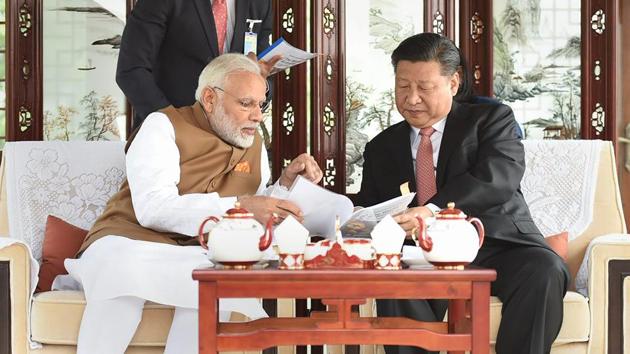What Wuhan tells us about Mamallapuram
Pragmatism will prevail. But given the informality of the summit, the outcomes will only become clear gradually
Today, carefully calibrated swings between bonhomie and brinkmanship define the nature of India-China ties. In April 2018, for instance, the inaugural Prime Minister Narendra Modi and President Xi Jinping informal summit in Wuhan, China, was confirmed five days before their meeting. This time again, the announcement for the second informal summit was made just three days before Xi lands in Chennai.

When such brinkmanship is mounted, and then followed by a walk in the woods or a boat ride, it seems to suggest that these two leaders are becoming global game changers, unlocking infinite opportunities. The Mamallapuram seaside walk, while reviewing Unesco-recognised heritage monuments, will allow Modi to invoke stories of their ancient history. The Pallava and Tang dynasties had once seen mutual economic, defence, cultural and people-to-people contact flourish. This should provide them an inspiring frame to visualise their role in this larger scheme of things.
It also fits the character of an “informal” summit. This implies leaders being neither driven by a structured agenda, nor geared towards any desired outcomes. Such open-ended meetings replicate the Chinese style, where paramount leaders never discuss specifics. They ruminate in philosophy and coin buzzwords and truisms. It is for their subordinates to later fathom and unpack these into specific policy perspectives, triggering fresh initiatives.
It was only several months after Wuhan that the two leaders were recognised for having achieved four prominent outcomes.
The first was the “Wuhan Spirit”, which reset post-Doklam China-India ties, marking a sharp rise in bilateral trade and investments.
The second was their unprecedented projection of personal chemistry. The December 1988 “three-minute handshake” between Deng Xiaoping and Rajiv Gandhi had formalised the post-1962 rapprochement. In the midst of the Doklam crisis, the 2017 Modi-Xi meeting at the Shanghai Cooperation Organisation summit had created the “Astana Consensus”, implying an agreement on ensuring that their differences must not become disputes.
Third, Modi and Xi agreed to provide strategic direction to their armed forces to ensure peace and tranquillity in their border regions. This saw a lowering of ingressions, until last month’s pushing-and-shoving north of Pangong Lake. Experts link this to China signalling displeasure with India’s reorganisation of Jammu and Kashmir and creation of Ladakh as a distinct Union Territory. China taking the Kashmir issue to United Nations Security Council and invoking “relevant UN resolutions” was triggered by its compulsions of reassuring its all-weather ally, Pakistan.
Fourth, Modi agreed to Xi’s 2+1 model, which meant China considering India as an equal partner for conceptualising joint third country projects. Recognising India’s discomfort with the China-Pakistan Economic Corridor, and its consequent disengagement with Xi’s favourite Belt and Road Initiative (BRI), this model saw India and China providing a joint training to Afghan diplomats last year. Both sides agree there could be many more projects like this.
What does all this imply for their Mamallapuram summit?
This means that while the optics of the summit remain assured, its outcomes will unfold only gradually. The most likely themes that may see forward momentum or traction will include perennial issues such as terrorism, climate change, inclusive Indo-Pacific, Regional Comprehensive Economic Partnership, 5G, trade deficit and people-to-people contacts. If asked, India could explain its take on Kashmir, but it remains off menu for this summit. There will no joint statements other than separate foreign office briefings.
India has responded to China’s references to the “relevant UN resolutions” and “keeping close watch” on Kashmir, during Prime Minister Imran Khan’s third China visit early this week. It will not disrupt the pragmatism of India-China officialese. Pakistan has become China’s compulsion that engenders worries, while India promises new opportunities, of course, with challenges.
Likewise, whether orchestrated or inadvertent, most India-China summits have been accompanied by increased ingressions on the Line of Actual Control (LoAC) or other power projections. Experts often tag these with China’s internal power struggles between political and military leaders or among various factions of the ruling Communist Party. Both sides have learnt to manage such discordant notes by underlining how not a single bullet has been fired on the India-China border since the Twang showdown of 1967. This explains why China has not reacted to India’s ongoing and largest high-altitude military exercises 100 km from the LoAC in Arunachal Pradesh.
On the flip side, Xi’s visit is not confined to India. He will return home on Saturday afternoon via Kathmandu. India has not yet responded to China’s April 2018 proposal for a China-Nepal-India Economic Corridor. So, like its China-Myanmar Economic Corridor of 2018, Xi may announce a China-Nepal Economic Corridor, which will further reinforce the belief that China no longer seeks India’s partnership in Xi’s most-ambitious BRI.
But, just like Wuhan, the second informal summit could also have its surprises, and open new avenues for their developmental partnership. It would be useful to watch the summit carefully, but also wait for the articulation of the outcomes over time.






